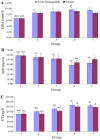Significance of malondialdehyde, superoxide dismutase and endotoxin levels in Budd-Chiari syndrome in patients and a rat model
- PMID: 30542478
- PMCID: PMC6257749
- DOI: 10.3892/etm.2018.6835
Significance of malondialdehyde, superoxide dismutase and endotoxin levels in Budd-Chiari syndrome in patients and a rat model
Abstract
Budd-Chiari syndrome (BCS) is a rare clinical syndrome caused by the obstruction of hepatic venous outflow. In theory, hepatic congestion and hypoxia induce pathological damage and changes in the liver. However, at present, laboratory evidence supporting this theory is lacking. The aim of the present study was to assess the expression and significance of the hypoxia-associated indicators malondialdehyde (MDA), superoxide dismutase (SOD) and endotoxin (ET) in the liver and serum of subjects with BCS. An animal model of BCS was established by partial ligation of the inferior vena cava (IVC) in rats. The levels of MDA, SOD and ET in the serum of BCS patients, as well as in the liver and serum of rats with BCS, were detected and analyzed. In human patients with BCS, the serum levels of MDA, ET and SOD were significantly different from those in healthy control subjects. In the animal model, similar trends were observed regarding the MDA, ET and SOD levels in liver homogenate and serum (P<0.05), the degree of which was more pronounced in the liver homogenate than in the serum. At 6 weeks after the surgery, these indicators reached peak/valley levels in the experimental group and were at least partially restored by week 12. A negative correlation between MDA and SOD, a positive correlation between MDA and ET, and a negative correlation between SOD and ET was identified. In conclusion, the levels of hypoxia-associated indicators significantly changed with BCS progression, suggesting that hypoxia is a major factor in the pathogenesis of BCS.
Keywords: Budd-Chiari syndrome; endotoxin; hypoxia; reactive oxygen species.
Figures






References
LinkOut - more resources
Full Text Sources
